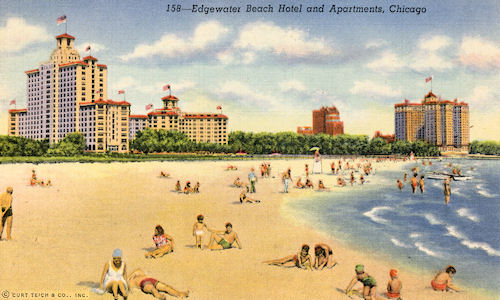
It was the place to be. In the first half of the twentieth century, when summertime arrived in Chicago, the scene at the Edgewater Beach Hotel never ceased to amaze. Beneath the moonlit sky, visitors flocked to the hotel’s beach front to dance the night away under the stars. The parties and concerts held here were legendary, stories of which spread across the nation through the wonders of radio. Cherishing the cool breeze emanating from Lake Michigan, visitors joyously swung to the rhythm of the greatest Big Band jazz orchestras of the day, celebrating the opulence of the Roaring Twenties atop the only outdoor marble dance floor in the country.
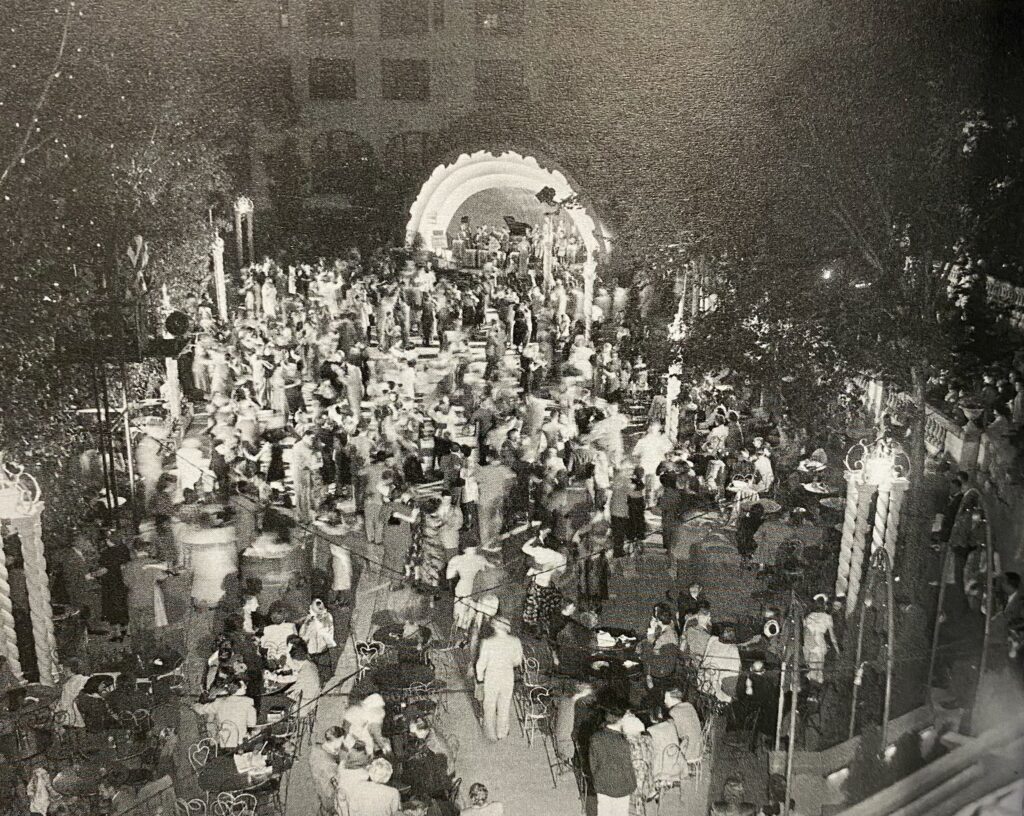
One of the key features of the Edgewater Beach Hotel was its beach walk, pictured here on a night in 1948. Dancing would run late into the evening, spurred on by jazz orchestras playing in the ‘Band Shell.’ Courtesy of the Edgewater Historical Society.

Heralded as the nation’s greatest urban beachfront resort, the Edgewater Beach Hotel’s grandeur represents a bygone era of extravagance. From its grand opening in 1916 through its tragic demolition in 1971, the Edgewater Beach Hotel hosted some of America’s most famous Hollywood stars, politicians, and athletes. Included among these famous citizens, however, were students from Mundelein, Chicago’s private Catholic women’s college. During the early days of the college in the 1930s and 40s, the women of Mundelein reveled in the hotel’s golden age. Through an analysis of its student newspaper The Skyscraper, archived here at the Women and Leadership Archives, it becomes clear that the Mundelein community cherished the hotel, employing it to both mark special occasions and to simply “dance the evening away” at the “ever popular” Edgewater Beach Hotel.i
The Edgewater Beach Hotel
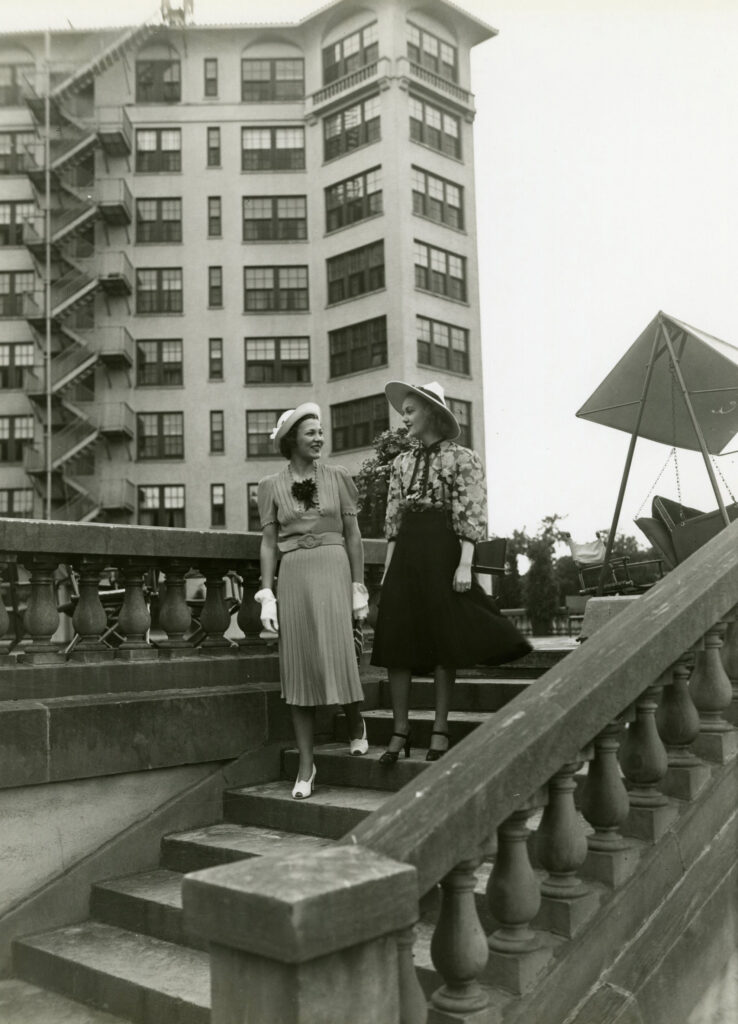
Designed by the architectural firm Marshall and Fox, the Edgewater Beach Hotel complex consisted of three luxury high-rise buildings containing 1,000 rooms. Painted in ‘Sunrise Yellow’ and ‘Sunset Pink’ to complement its beautiful lakefront location, the urban resort was designed as a refuge from life in the city. In addition to the 1,000-foot beach walk, the complex also included tennis courts, one of the nation’s first indoor shopping arcades, strolling gardens, swimming pools, ballrooms, lounges, and the first indoor parking garage in the world. If one was lucky enough, they could even arrive at the hotel by seaplane or boat to beat the infamous traffic plaguing Lake Shore Drive.ii

Built along a seawall on the shores of Lake Michigan, natural erosion caused the shore’s beach to gradually expand a dozen acres, reaching its peak in the 1940s. In the sweltering Chicago summers, the lake’s breeze provided a much-needed relief. To attract business in the winter months, a skating rink was even placed atop the tennis courts. The grandest indoor space in the hotel, the Marine Dining Room, hosted events and dances daily, backed by music from the most famous big band jazz orchestras of the day, including Paul Whiteman and Xavier Zugat. The music proved so popular that a radio booth was installed right in the dining room, broadcast by NBC into living rooms across the nation.iii

Mundelein Students at the Edgewater Beach Hotel
During the first two decades of its existence in the 1930s and 40s, Mundelein College’s student newspaper, The Skyscraper, reported often on the happenings at the Edgewater Beach Hotel, dubbing it “a favorite spot among Mundeleinites.”iv Whether it be attending banquets, birthdays, proms and balls, New Year’s Eve parties, club meetings, or card parties, students patronized the “the popular hotel of the north side” whenever they got the chance.v
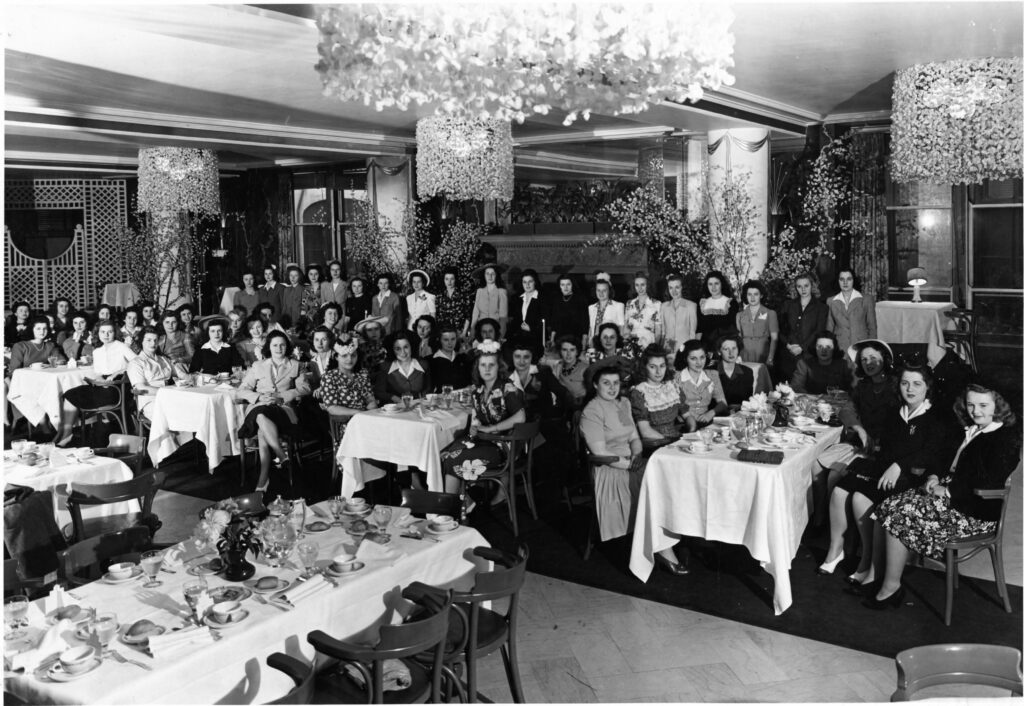
Mundelein students frequented the hotel on both a formal and informal basis, cherishing special events held at the hotel, while also enjoying its famous dancing and music in their own time. Sports were very popular at Mundelein, and during the 1940s the Women’s Athletic Assocation (W.A.A.) held their annual awards banquet, the “climax of the year’s events,” in the hotel’s Marine Dining Room.vi During WWII, Midshipmen who had graduated from the local Navy Reserve training center held their graduation celebrations at the hotel, attracting Mundelein students to the hotel “amidst May flowers blossomed.”vii
On Friday nights, the hotel hosted ‘College Nights,’ where students from across the Midwest came to unwind and socialize. In October of 1935, a group of Mundelein students enjoyed “a glorious evening” at the Edgewater Beach Hotel, accompanied by their “handsome Notre Dame escorts.”viii A few weeks later, another group of students could be seen on college night “waving the Mundelein colors,” with Jane McKeever “dancing to her heart’s content.”ix
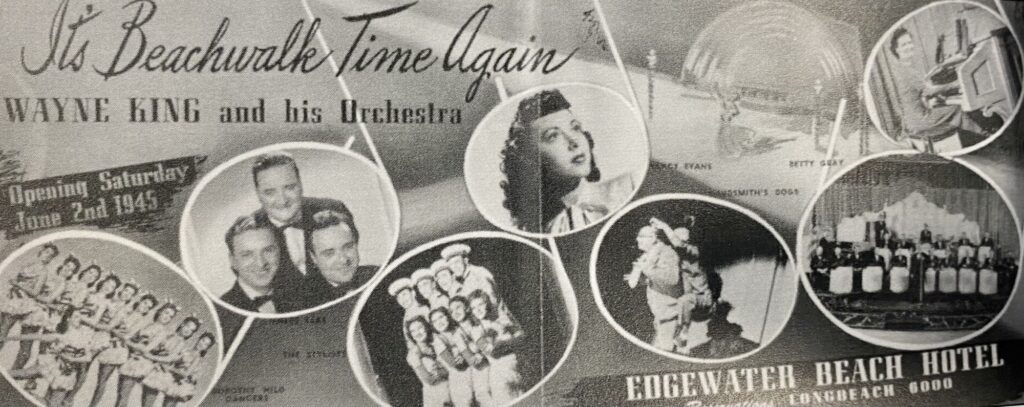
In addition to listening to performances at the Edgewater Beach Hotel, Mundelein students also performed there. In December of 1933, Mildred Sperry, one of Mundelein’s “most versatile pianists” played a beautiful rendition of Liszt Rhapsody No. 8 in the hotel’s Crystal Ballroom.x A few years later in 1938, Kitty Keller’s outstanding “toe dancing” ability earned her a dancing engagement at the hotel.xi Student Ruth McCormick was reported to have been in “in a singing mood” at Edgewater Beach in 1939.xii And lastly, Dellamae Laughlin, soprano soloist, performed for the Chicago Women’s Musical Society spring luncheon in 1945.xiii
The Downfall of the Edgewater Beach Hotel
In spite of the great heights it had reached, the Edgewater Beach Hotel’s popularity declined rapidly by the 1950s and 60s. With the hotel’s pristine beaches being one of its main selling points, the continued expansion of Lake Shore Drive north proved too much for the hotel to withstand, eliminating its lakefront status. What is more, with the advent of air conditioning, the lake’s cooling breezes lost its novelty. With Americans now vacationing farther away from home, the concept of an urban waterfront resort no longer attracted large enough crowds.xiv
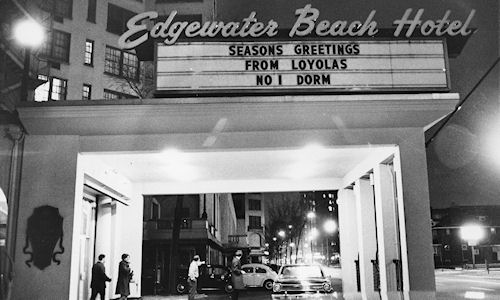
While the hotel enjoyed a brief afterlife when it was leased by Loyola University as a temporary dormitory in 1968, the hotel was demolished between 1969 and 1971.xv The building’s construction was so solid it took over 13 months to tear the complex down. If you drive down Sheridan Road today, you still can see the 1928 Edgewater Beach Apartments building, the last remaining structure of the complex. The next time you pass it by, maybe you can imagine the big band music radiating across the lake shore and the dancing crowds reveling at a Chicago icon: The Edgewater Beach Hotel.

Willow is a Graduate Assistant at the Women and Leadership Archives (WLA). They are in the final year of Loyola University Chicago’s M.A. in Public History degree program. In their spare time, they are a stained-glass artist who designs windows and lampshades.
Loyola University Chicago’s Women and Leadership Archives Blog is designed to provide a positive environment for the Loyola community to discuss important issues and ideas. Differences of opinion are encouraged. We invite comments in response to posts and ask that you write in a civil and respectful manner. All comments will be screened for tone and content and must include the first and last name of the author and a valid email address. The appearance of comments on the blog does not imply the University’s endorsement or acceptance of views expressed. Questions? Please contact the WLA at wlarchives@LUC.edu.
Citations
“Loyola to Use Edgewater for Housing.” Chicago Tribune (1963-1996), Aug 28, 1968. https://flagship.luc.edu/login?url=https://www.proquest.com/historical-newspapers/loyola-use-edgewater-housing/docview/168803426/se-2.
John Holden and Gemperle, Kathryn Gemperle. Images of America: Remembering Edgewater Beach Hotel. Charleson, S.C.: Arcadia Publishing. 2021
Hunter, Devin, “Growing Diversity: Urban Renewal, Community Activism, and the Politics of Cultural Diversity in Uptown Chicago, 1940-1970.” Dissertations. 2015.
Figure 1: Greene. 1991. Edgewater Beach Apartments. Artist Proof. Box 12, Folder 3, Mary Ann Smith Papers, Women and Leadership Archives, Chicago, IL.
Figure 2: “Jane Carney and Geraldine Ferstel at Edgewater Beach, June 25, 1938.” Photograph. Box 42, Folder 12, Mundelein College Photograph Collection, Women and Leadership Archives, Chicago, IL.
Figure 3: “Women’s Athletic Association Annual Awards Banquet, Edgewater Beach Hotel, 1940.” Photograph. Box 7, Folder 8, Mundelein College Photograph Collection, Women and Leadership Archives, Chicago, IL.
Figure 4: “Edgewater Beach Hotel and Apartments, looking NW Post-1923.” Postcard. Courtesy of the Edgewater Historical Society.
Figure 5: “Edgewater Beach Hotel Beach Walk.” Postcard. Courtesy of Edgewater Historical Society.
Figure 6: “Edgewater Beach Hotel Marine Dining Room.” Postcard. Courtesy of the Edgewater Historical Society.
Figure 7: “Edgewater Beach Hotel Beach Walk at Night, 1948.” Photograph. Courtesy of the Edgewater Historical Society.
Figure 8: “Edgewater Beach Hotel Loyola Dormitory Marquee, 1968.” Photograph. Courtesy of the Edgewater Historical Society.
